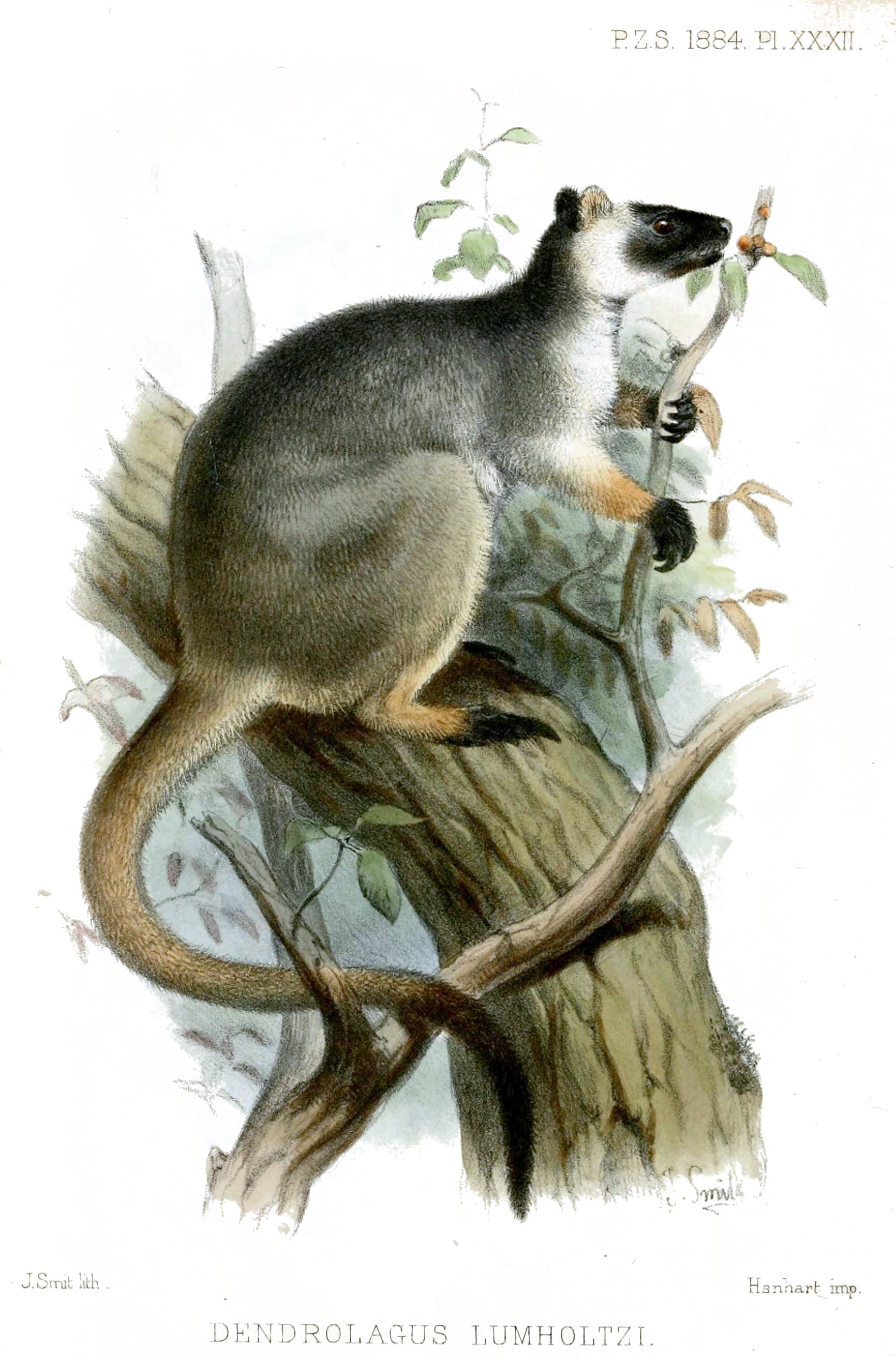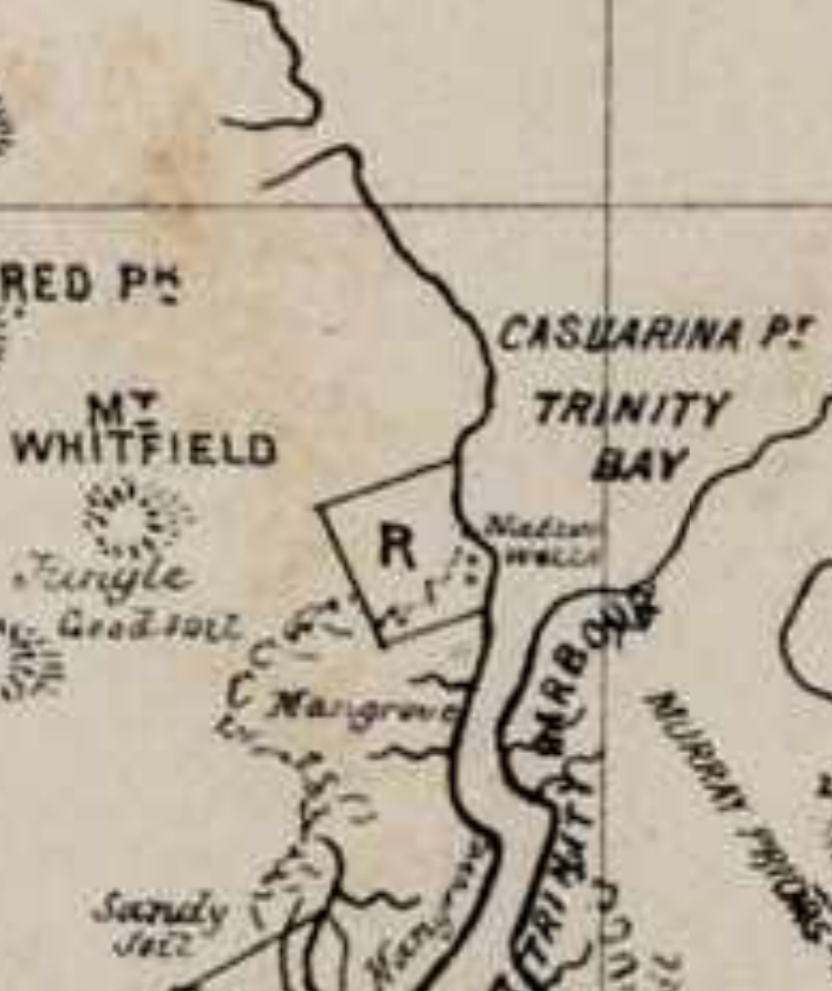|
Lumholtz's Tree Kangaroo
Lumholtz's tree-kangaroo (''Dendrolagus lumholtzi'') is a rare, long-tailed bear-like mammal found in rainforests in northeastern Australia. Like most tree-kangaroos (genus ''Dendrolagus''), it lives alone in trees and feeds on plant matter. It belongs to the macropod family (Macropodidae) with kangaroos, and carries its young in a pouch like other marsupials. It is threatened by climate change and diseases, and is found in the hilly, fertile Atherton Tableland in Queensland. Name The species name ''lumholtzi'' is after the Norwegian explorer Carl Sofus Lumholtz (1851–1922), who was the first European to record a specimen in 1883. The local indigenous Dyirbal and Yidiny language name may have been either "mabi" or "mapi". Description and habitat It is the smallest of all tree-kangaroos, with males weighing an average of 7.2 kg (16 lbs) and females 5.9 kg (13 lbs). Its head and body length ranges from 480–650 mm, and its tail, 600–740 mm. I ... [...More Info...] [...Related Items...] OR: [Wikipedia] [Google] [Baidu] |
David Fleay Wildlife Park
David Fleay Wildlife Park is a heritage-listed wildlife park at Fleays Wildlife Park Conservation Park, Tallebudgera Creek Road, Tallebudgera, Queensland, Australia. It was built from 1952 to 1983. It is also known as Fleays Wildlife Park. It was added to the Queensland Heritage Register on 23 February 2001. Established by Australian naturalist David Fleay in 1952, the Park today is home to many native animals, which are displayed in surroundings similar to their natural habitats. Managed by the Environmental Protection Agency, the Park aims to raise community awareness about the need to protect native animals, especially rare and threatened species. The Park has a long tradition of breeding native animals and also includes an animal hospital for sick, injured and orphaned animals. After investigating areas around Brisbane and South East Queensland, Fleay selected the Tallebudgera Estuary as a suitable site for a fauna reserve in late 1951. He acquired land there for a reser ... [...More Info...] [...Related Items...] OR: [Wikipedia] [Google] [Baidu] |
Yidiny Language
Yidiny (also spelled Yidiɲ, Yidiñ, Jidinj, Jidinʲ, Yidinʸ, Yidiń ) is a nearly extinct Australian Aboriginal language, spoken by the Yidinji people of north-east Queensland. Its traditional language region is within the local government areas of Cairns Region and Tablelands Region, in such localities as Cairns, Gordonvale, and the Mulgrave River, and the southern part of the Atherton Tableland including Atherton and Kairi. Classification Yidiny forms a separate branch of Pama–Nyungan. It is sometimes grouped with Djabugay as Yidinyic, but Bowern (2011) retains Djabugay in its traditional place within the Paman languages. Phonology Vowels Yidiny has the typical Australian vowel system of /a, i, u/. Yidiny also displays contrastive vowel length. Consonants Yidiny consonants, with no underlyingly voiceless consonants, are posited. Dixon (1977) gives the two rhotics as a "trilled apical rhotic" and a "retroflex continuant". Grammar The Yidiny language has a number of p ... [...More Info...] [...Related Items...] OR: [Wikipedia] [Google] [Baidu] |
Near Threatened Animals
NEAR or Near may refer to: People * Thomas J. Near, US evolutionary ichthyologist * Near, a developer who created the higan emulator Science, mathematics, technology, biology, and medicine * National Emergency Alarm Repeater (NEAR), a former alarm device to warn civilians of a foreign nuclear attack on the United States * National Emergency Airway Registry (NEAR), a patient registry for intubations in the United States * Nicking enzyme amplification reaction (NEAR), a method of DNA amplification * NEAR Shoemaker, a spacecraft that studied the near-Earth asteroid Eros * Nearness or proximity space *"Near", a city browser by NearGlobal Television, film, music, and books * Near (Death Note), ''Nate River'', a character Other uses * Near v. Minnesota, a U.S. press freedom Supreme Court decision * New England Auto Racers Hall of Fame The New England Auto Racers Hall of Fame is a hall of fame for racing-related people in the New England region of the United States. NEAR was ... [...More Info...] [...Related Items...] OR: [Wikipedia] [Google] [Baidu] |
Mammals Of Queensland
Mammals () are a group of vertebrate animals constituting the class Mammalia (), characterized by the presence of mammary glands which in females produce milk for feeding (nursing) their young, a neocortex (a region of the brain), fur or hair, and three middle ear bones. These characteristics distinguish them from reptiles (including birds) from which they diverged in the Carboniferous, over 300 million years ago. Around 6,400 extant species of mammals have been described divided into 29 orders. The largest orders, in terms of number of species, are the rodents, bats, and Eulipotyphla (hedgehogs, moles, shrews, and others). The next three are the Primates (including humans, apes, monkeys, and others), the Artiodactyla (cetaceans and even-toed ungulates), and the Carnivora (cats, dogs, seals, and others). In terms of cladistics, which reflects evolutionary history, mammals are the only living members of the Synapsida (synapsids); this clade, together with Sauropsid ... [...More Info...] [...Related Items...] OR: [Wikipedia] [Google] [Baidu] |
Endemic Fauna Of Australia
Endemism is the state of a species being found in a single defined geographic location, such as an island, state, nation, country or other defined zone; organisms that are indigenous to a place are not endemic to it if they are also found elsewhere. For example, the Cape sugarbird is found exclusively in southwestern South Africa and is therefore said to be ''endemic'' to that particular part of the world. An endemic species can be also be referred to as an ''endemism'' or in scientific literature as an ''endemite''. For example '' Cytisus aeolicus'' is an endemite of the Italian flora. '' Adzharia renschi'' was once believed to be an endemite of the Caucasus, but it was later discovered to be a non-indigenous species from South America belonging to a different genus. The extreme opposite of an endemic species is one with a cosmopolitan distribution, having a global or widespread range. A rare alternative term for a species that is endemic is "precinctive", which applies to s ... [...More Info...] [...Related Items...] OR: [Wikipedia] [Google] [Baidu] |
Marsupials Of Australia
Marsupials are any members of the mammalian infraclass Marsupialia. All extant marsupials are endemic to Australasia, Wallacea and the Americas. A distinctive characteristic common to most of these species is that the young are carried in a pouch. Marsupials include opossums, Tasmanian devils, kangaroos, koalas, wombats, wallabies, bandicoots, and the extinct thylacine. Marsupials represent the clade originating from the last common ancestor of extant metatherians, the group containing all mammals more closely related to marsupials than to placentals. They give birth to relatively undeveloped young that often reside in a pouch located on their mothers' abdomen for a certain amount of time. Close to 70% of the 334 extant species occur on the Australian continent (the mainland, Tasmania, New Guinea and nearby islands). The remaining 30% are found in the Americas—primarily in South America, thirteen in Central America, and one species, the Virginia opossum, in North America, nor ... [...More Info...] [...Related Items...] OR: [Wikipedia] [Google] [Baidu] |
Macropods
Macropod may refer to: * Macropodidae, a marsupial family which includes kangaroos, wallabies, tree-kangaroos, pademelons, and several others * Macropodiformes The Macropodiformes , also known as macropods, are one of the three suborders of the large marsupial order Diprotodontia. They may in fact be nested within one of the suborders, Phalangeriformes. Kangaroos, wallabies and allies, bettongs, potoro ..., a marsupial suborder which includes kangaroos, wallabies and allies, bettongs, potoroos, and rat kangaroos {{disambiguation Animal common name disambiguation pages ... [...More Info...] [...Related Items...] OR: [Wikipedia] [Google] [Baidu] |
Cairns
Cairns (, ) is a city in Queensland, Australia, on the tropical north east coast of Far North Queensland. The population in June 2019 was 153,952, having grown on average 1.02% annually over the preceding five years. The city is the 5th-most-populous in Queensland, and 15th in Australia. The city was founded in 1876 and named after Sir William Wellington Cairns, following the discovery of gold in the Hodgkinson river. Throughout the late 19th century, Cairns prospered from the settlement of Chinese immigrants who helped develop the region's agriculture. Cairns also served as a port for blackbirding ships, bringing slaves and indentured labourers to the sugar plantations of Innisfail. During World War II, the city became a staging ground for the Allied Forces in the Battle of the Coral Sea. By the late 20th century the city had become a centre of international tourism, and in the early 21st century has developed into a major metropolitan city. Cairns is a popular tourist ... [...More Info...] [...Related Items...] OR: [Wikipedia] [Google] [Baidu] |
IUCN
The International Union for Conservation of Nature (IUCN; officially International Union for Conservation of Nature and Natural Resources) is an international organization working in the field of nature conservation and sustainable use of natural resources. It is involved in data gathering and analysis, research, field projects, advocacy, and education. IUCN's mission is to "influence, encourage and assist societies throughout the world to conserve nature and to ensure that any use of natural resources is equitable and ecologically sustainable". Over the past decades, IUCN has widened its focus beyond conservation ecology and now incorporates issues related to sustainable development in its projects. IUCN does not itself aim to mobilize the public in support of nature conservation. It tries to influence the actions of governments, business and other stakeholders by providing information and advice and through building partnerships. The organization is best known to the wider ... [...More Info...] [...Related Items...] OR: [Wikipedia] [Google] [Baidu] |
Dyirbal Language
Dyirbal (also ''Djirubal'') is an Australian Aboriginal language spoken in northeast Queensland by the Dyirbal people. In 2016, the Australian Bureau of Statistics reported that there were 8 speakers of the language. It is a member of the small Dyirbalic branch of the Pama–Nyungan family. It possesses many outstanding features that have made it well known among linguists. In the years since the Dyirbal grammar by Robert Dixon was published in 1972, Dyirbal has steadily moved closer to extinction as younger community members have failed to learn it. Dialects There are many different groups speaking dialects of Dyirbal language. Researcher Robert Dixon estimates that Dyirbal had, at its peak, 10 dialects. Dialects include: * Dyirbal (or Jirrbal) spoken by the Dyirbalŋan * Mamu, spoken by the Waɽibara, Dulgubara, Bagiɽgabara, Dyiɽibara, and Mandubara (There are also different types of Mamu spoken by individual groups, such as Warribara Mamu, and Dulgubara Mamu) * Gi ... [...More Info...] [...Related Items...] OR: [Wikipedia] [Google] [Baidu] |
Burleigh Heads, Queensland
Burleigh Heads is a suburb in the City of Gold Coast, Queensland, Australia. In the , Burleigh Heads had a population of 10,077 people. Geography Burleigh Head is a cape () jutting into the Coral Sea at the northern mouth of Tallebudgera Creek. Rising to a height of , Burleigh Head is a prominent local landmark. Burleigh Beach facing the Coral Sea commences at Burleigh Head and extends north (). The suburb has two distinct parts. The north-eastern part of the suburb is a narrow coastal area bounded to the north-east by the Coral Sea and includes Burleigh Head. The south-western part then extends inland along Tallebudgera Creek. The centre of the Burleigh beach area is James Street (), which consists of cafes, delis, hairdressers, retailers, chemists, restaurants and charity stores. Koala Park is a neighbourhood in the north-east of the suburb (). It is a residential area alongside Tallebudgera Creek that is surrounded by bushland consisting of Burleigh Head National Park, B ... [...More Info...] [...Related Items...] OR: [Wikipedia] [Google] [Baidu] |

.jpg)
_(white_background).jpg)


